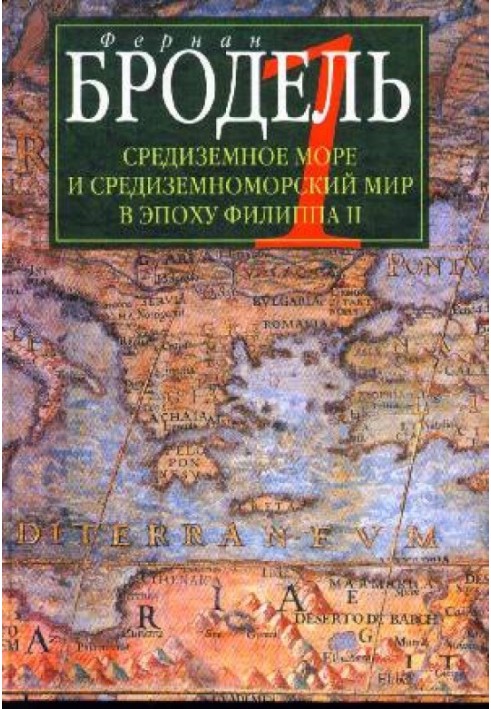Part 1. The role of the environment
 Instant download
Instant download
after payment (24/7)
 Wide range of formats
Wide range of formats
(for all gadgets)
 Full book
Full book
(including for Apple and Android)
The classic work, which made the French historian famous, was translated into Russian for the first time. The first edition of the work, dedicated to the history of the Mediterranean in the second half of the 16th century (but far beyond this chronological and geographical framework), appeared in 1949. It attracted attention attention to the generalization of the experience of several generations of historians from different countries, including the innovative research of the Annales school, as well as the originality of Braudel’s historical method. He introduced into use the concepts of historical periods of long duration, structures and conjunctures, against the background of which specific events, “the dust of everyday life,” are considered. Also pioneering was the comprehensive approach to the study of the entire region, which at that time was for Europeans the center of the whole world, in its totality, with the release beyond the usual political framework and historical stereotypes, and most importantly, in interaction with the natural environment. On the cover: Etienne Duperac, Giovanni Antonio da Varese and assistants. Mediterranean basin. The third Loggia, the so-called Loggia of Cosmography. Vatican.
CONTENTS:Preface to the first edition 15Preface to the second edition 23Preface to the third edition 26Preface to the fourth edition 26PART I. THE ROLE OF THE ENVIRONMENTI. PENINSULAS: MOUNTAINS, PLAINS, PLATE MOUNTAINS 331. Mountains First 33Physical and Human Characteristics 34Definition of Mountains 38Mountains, Civilizations and Religions 41Mountain Freedom 45Mountain Resources and Budget 48Mountain Men in the City 51The History of Mountains—the Beginning of Mediterranean History? 582. Plateaus, foothills and hills 60 Elevated plains 60 Country growing on a trellis 63 Hills 663. Plains 68Water problems: malaria 71Reclamation on the plains 75The example of Lombardy 81Large landowners and poor peasants 84Short-term changes on the plains: Venetian Terra Farm 88In the long term: the fate of the Roman Campania 91The power of the plains: Andalusia 924. Transhumance or nomadic way of life:D va Mediterranean 96 Cattle drives 97 The origin of nomadism is more ancient than transhumance 99 Transhumance in Castile 104 Comparisons and compilation of a general map 108 Dromedaries and camels: invasions of Arabs and Turks Nomadic life of the Balkans, Anatolia and North Africa in the light of Western sources 113 More than hundred-year cycles 116 Notes to Chapter I. PENINSULAS: PLAINS , PLATE MOUNTAINII. THE HEART OF THE MEDITERRANEAN. SEAS AND COASTS1. water plains 141Coastal navigation 141At the dawn of the Portuguese discoveries 147Small seas, the foundation of history 148Black Sea - Constantinople reserve 150Archipelago, Venetian and Genoese 154Between Tunisia and Sicily 155Mediterranean English Channel 157Tyrrhenian basin 161Adriatic 1 66To the East and West of Sicily 176The Two Worlds of the Mediterranean 178The Lesson of the Turkish and Spanish Empires 179Po the other side of politics 1822. Coasts of the continents 183 Peoples of the sea 183 Underdevelopment of coastal regions 186 Metropolises 191 Ups and downs in the life of the sea 1933. Islands 195 Isolated worlds? 197Uncertainty about the future 199On the paths of great history 201Emigrants from the islands 206Islands surrounded by land 208Peninsulas." 210Notes to Chapter II. THE HEART OF THE MEDITERRANEAN. SEA AND COAST III. BORDERS, OR EXPANSION UNDERSTANDING THE MEDITERRANEANThe Mediterranean by historical standards 2371. The Sahara, the second face of the Mediterranean 239The Sahara: near and far limits 239Poverty and need 242Transitions over long distances 245Encounters with steppe peoples and their domestication 247Caravans of gold and spices 251Oases 256 Geographical space of Islam 2582. Europe and the Mediterranean Sea 260 Crossroads and meridional roads 260Russian Isthmus: to the Black or Caspian Sea 263From the Balkans to Danzig: Polish Isthmus 267German Isthmus: general scheme 276Alps 280The third character, the many faces of Germany 283From Genoa to Antwerp, from Venice to Hamburg: new conditions of commodity circulation 286Trade balance and emigration 289French Isthmus from Rouen to Marseille 291Europe and Mediterranean Sea 2983. Atlantic Ocean 300Various images of the Atlantic 300Mediterranean lessons from the ocean 301The fate of the Atlantic in the sixteenth century 304Belated decline 308Notes to chapter III. BOUNDARIES, OR EXPANDING UNDERSTANDING OF THE MEDITERRANEAN IV. PHYSICAL-GEOGRAPHICAL UNITY: CLIMATE AND HISTORY1. Climatic unity 324Atlantic and Sahara 325Climate uniformity 327Droughts are the scourge of the Mediterranean 3322. Seasons 341The stubbornness of winter 341Cessation of navigation 343Peace and winter rumors 349Severe winters 352The bustle of summer life 353Summer epidemics 355Mediterranean climate and the East 356Seasonal rhythms and statistics 357Determinism and economic life 3643. Has the climate changed compared to 16th century? 365Additional Notes 371Notes to Chapter IV. PHYSICAL-GEOGRAPHICAL UNITY: CLIMATE AND HISTORYv. SOCIAL INTEGRITY: ROADS AND CITIES, CITIES AND ROADS1. Sea routes and land roads 386The vitality of roads 389Outdated means of transport 392The predominance of land roads around 1600? 395The problem of land communications in itself 400The double lesson of Venice 402Transportation statistics using the example of Spain 405The problem of transport routes in the long term 4072. Navigation: ship tonnage and market conditions 408Large-tonnage ships and small sailing ships in the 15th century 414The first successes of small-tonnage ships 416About the Atlantic in the 16th century 417 On the Mediterranean Sea 4233. The role of cities 430Cities and roads 430Transfer points 435On the way to the bank 437The urban cycle and recessions 442An attempt to create a rough typology 4434. Cities as witnesses of their time 445Demographic growth 445Old and new troubles: crop failures and food problems 448Old and new troubles: epidemics 453The inevitability of immigration 456Urban political crises 461The advantage of financial centers 465Royal and imperial cities 469In defense of the capital 476Anticipating what follows 477Notes to Chapter V. SOCIAL INTEGRITY: ROADS AND CITIES, CITIES AND ROADSList of illustrations 495
Data sheet
- Name of the Author
- Фернан Бродель
- Language
- Russian
- Translator
- Марк Аркадьевич Юсим

















